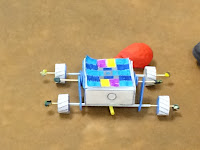Scratch- Digital Stories---Fractured Fairy Tales
Last year, I used i-movie and audacity as the format for students to make our digital story about Alberta, and I was looking for a new “hook”. In December, I was introduced to the program Scratch and I became interested because of the emphasis on coding that I had been reading about. I didn’t just want to plunk the program in front of students and say here, construct a story. It was important for me to know how and why I was using it before I gave it to students. I went to a session at Teacher Convention, I talked with team members and with teachers from other schools in order to learn how to best use and implement scratch. As it turned out I should have just set in front of students and allowed them to “play”.
I had wanted students to use Scratch as the format to tell their story but it didn’t have the features students were wanting such as changing backgrounds to fit their voice and so students suggested they use Scratch to tell their fractured fairy tale.
Our “Scratch” Journey
Step 1: Students participated in the robot activity where they learned that they had to give, “code” specific instructions to get their partner to walk a square. This activity helped students to understand that when coding they need to “code” every step because their robot won’t know what to do. Students had some idea of how coding worked because they had used Mindstorm Robots earlier in the year.
Step 2: Students were provided a brief tutorial on how to use Scratch. They were shown the different features and the basics.
Step 3: Students were taught what a fractured fairytale was and were provided a graphic organizer to help them plan their story.
Step 4: Even though I thought they needed more instruction, I gave them a computer. Students explored and experimented with the program. They did an outstanding job.
Step 5: Armed with the knowledge of how to write a fractured fairytale, a graphic organizer and a program to share their story, students were off. Students helped and supported one another and they were able to create a story.
I learned that even though I didn’t understand each part of the program, students were motivated to learn on their own and to teach me. I still have lots to learn about how to utilize Scratch but it was fun to use a different program.

































